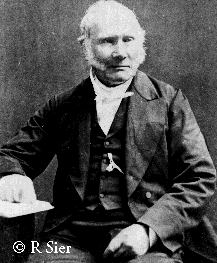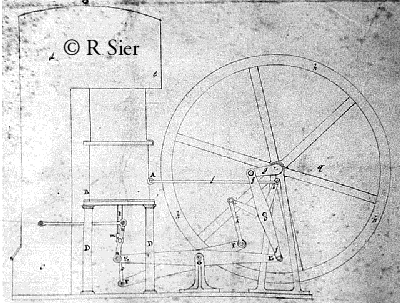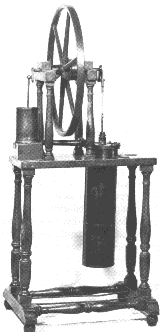

 Robert Stirling patented his Heat Economiser in 1816. The patent described a number of applications for use in glass and other furnaces. Also described was a motive power engine incorporating his ideas and designed to work with a reduced fuel consumption compared with the designs of steam engines then available. Robert Stirling patented his Heat Economiser in 1816. The patent described a number of applications for use in glass and other furnaces. Also described was a motive power engine incorporating his ideas and designed to work with a reduced fuel consumption compared with the designs of steam engines then available.
The drawing shown, right, is taken from his English patent. This patent is hand written, and a comparison with known examples of Stirling's own hand writing clearly shows the writing to be that of Robert Stirling and there is no reason not to believe that he also penned the drawings. In 1818 Robert Stirling erected an air engine to his design to pump water from a stone quarry. In the 1820s he teamed up with his younger brother James who suggested that greater power output might be obtained using air at pressures greater than atmospheric pressure. Further patents were obtained in 1827 and 1840, for improvements in air engines. Robert Stirling's patent of 1816 contained all the elements of what is now termed the STIRLING CYCLE ENGINE. That is a power piston, a displacer to move the enclosed air between the hot and cold ends and a regenerator set between the hot and cold ends of the displacer cylinder. Closed cycle operation with external heating.
|
 Regrettably none of Stirling's experimental work or papers have survived except for two model engines built by him when he was a Minister at Kilmarnock. These models were donated to the Universities of Glasgow and Edinburgh some time before 1824. At Edinburgh Stirling's engine was used by Professor John Leslie, who thought practical demonstration important. In 1975 the department of Natural Philosophy at Edinburgh University donated their engine to the Royal Scottish Museum where it is now on display. At Glasgow the engine was put in to store where it lay forgotten until discovered, in 1847, by William Thomson, then professor of Natural Philosophy, who later became Lord Kelvin. Thomson used the model to show that Stirling's machine worked on a reversible cycle. The engine was in constant use by Thomson for lecture illustration. It is still at Glasgow and can be found on display with other historical artifacts in the refectory of the department of Physics. Regrettably none of Stirling's experimental work or papers have survived except for two model engines built by him when he was a Minister at Kilmarnock. These models were donated to the Universities of Glasgow and Edinburgh some time before 1824. At Edinburgh Stirling's engine was used by Professor John Leslie, who thought practical demonstration important. In 1975 the department of Natural Philosophy at Edinburgh University donated their engine to the Royal Scottish Museum where it is now on display. At Glasgow the engine was put in to store where it lay forgotten until discovered, in 1847, by William Thomson, then professor of Natural Philosophy, who later became Lord Kelvin. Thomson used the model to show that Stirling's machine worked on a reversible cycle. The engine was in constant use by Thomson for lecture illustration. It is still at Glasgow and can be found on display with other historical artifacts in the refectory of the department of Physics.A sectioned replica of the engine can be found on display at the London Science Museum. |
Bibliography:
